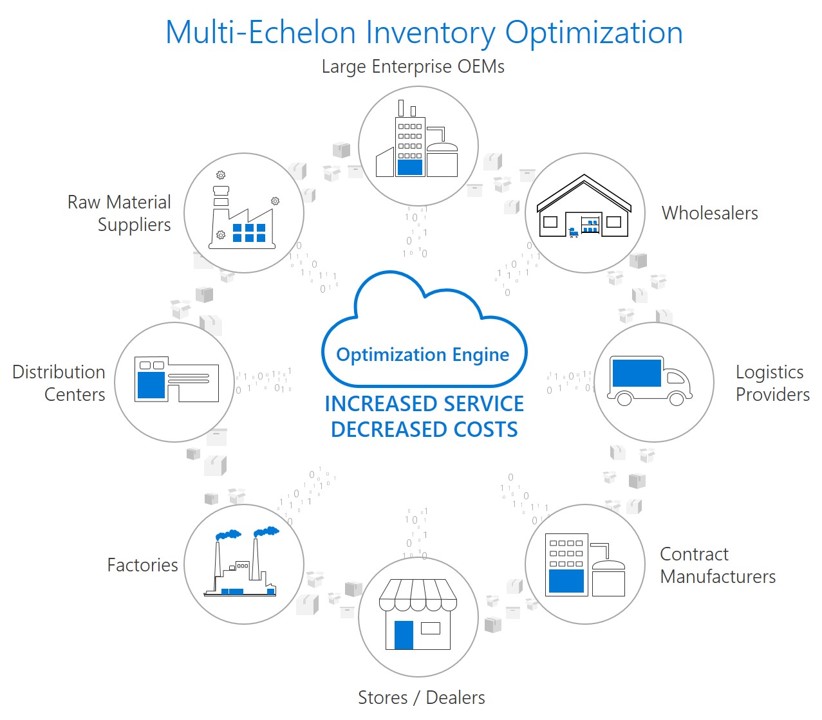
Multi-echelon inventory optimization vs inventory optimization
The subway system is the lifeblood of New York City, carrying an average of 5.7 million people per day across 472 stations. Each station is part of a larger system and operates on a set schedule under one management umbrella. Imagine what would happen if each station optimized its schedule and traffic independently: city-wide subway chaos would ensue. Now consider that by not optimizing your supply chain and inventory from a global vantage point you may be creating, if not outright chaos, a much less efficient network than you could have.
There are many pieces of the modern manufacturing supply chain, and when it comes to inventory management, each one must operate as a part of a global single system to be most effective. To truly serve the end customer, all manufacturing echelons, such as raw materials suppliers, factories, distribution centers, and wholesalers, need to ensure that the right stock is at the right place at the right time. This is no easy task.
Making matters worse, many manufacturers are currently using legacy systems such as rules of thumb and outdated algorithms to help forecast customer demand and manage inventory. For example, an organization may set inventory targets for a specific product at a specific location based on average demand for a broader product family across a wide geographic region. This approach, however, does not account for variability: individual products may ultimately have a similar average demand but dramatically different order patterns. Many supply chain planners also use instinct and guesswork to set inventory targets, inserting significant bias into the supply chain.
To stay competitive in today’s market, manufacturers are turning to two types of solutions to handle their supply chain: inventory optimization (IO) and multi-echelon inventory optimization (MEIO). The overarching goal of both IO and MEIO solutions is to efficiently match inventory levels to accommodate forecasted demand. This enables manufacturers to keep inventory levels low, move inventory as quickly as possible, and ensure high service levels for customers.
Let’s first look at how inventory optimization solutions tackle effective supply chain planning.
The standard approach to inventory optimization

A good inventory optimization solution utilizes identifies optimal inventory levels at individual stages in the supply chain. With advanced analytics, statistical algorithms, and sometimes machine learning to automatically adjust stocks, manufacturers can accurately address demand volatility and manage even slow-moving products in the long tail.
Inventory optimization models demand and determines appropriate inventory for individual echelons in the supply chain. For example, if a supply chain contains raw materials suppliers, factories, and warehouses, typical inventory optimization solutions manage stock at each stage separately—optimizing supply at warehouses distinctly from factories. By bringing to bear statistical demand forecasting, advanced analytics, and intelligent inventory adjustments, manufacturers see dramatic improvements over the old rules of thumb, arbitrary segmentation, and one-size-fits-all approaches. The results are powerful and immediate: improved service levels, increased working capital, and decreased operational costs. These solutions greatly improve business outcomes and are an important first step to modernizing inventory management.
The evolution of intelligent supply chain planning: multi-echelon inventory optimization

MEIO solutions take inventory optimization a step further for manufacturers with complex supply chains. An effective MEIO solution suggests the right levels of inventory at each stage of the supply chain by simultaneously optimizing inventory balance across multiple echelons and locations. Picking up from our previous example, with an MEIO approach, manufacturers would analyze demand forecasts from the warehouse, factory, and raw material supplier to account for an all-encompassing view of the supply chain.
So how does this approach further help inventory planners? MEIO enables manufacturers to strategically stock individual inventories across all echelons of the supply chain, further increasing customer service levels while simultaneously decreasing costs. Additionally, this approach enables manufacturers to focus on the optimal replenishment frequency for individual products at individual locations. The increased visibility MEIO provides empowers centralized demand planning, reducing costs across the supply chain and streamlining operations.
The reality is that manufacturers need to evolve their existing forecasting solutions and incorporate some level of inventory optimization. MEIO provides the next step for manufacturers with complex supply chains by keeping service levels high and inventory costs low.
Transform the supply chain with a multi-echelon inventory optimization solution
ToolsGroup provides best-in-class multi-echelon inventory optimization, leveraging proprietary algorithms to optimize inventory and customer service levels across the entire supply chain. ToolsGroup MEIO empowers manufacturers to enhance demand modeling and balance inventories across complex supply chains using the data they already have. A leading HVAC provider with a complicated distribution network saw 16% service level improvement and 25% increased inventory turns with ToolsGroup’s solution.
ToolsGroup’s Multi-Echelon Inventory Optimization solution, Built on Microsoft Cloud technology, is transforming manufacturing operations. To learn more about how ToolsGroup can help you increase service levels and free up working capital in your business, try the demo today on Microsoft AppSource.




